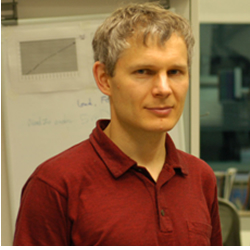| |
| |
| Alexei Morozov, Ph.D., Investigator |
 |
Dr. Morozov received his M.S. from Lomonosov Moscow State University, and Ph. D from the University of Illinois at Chicago working on the regulation of cell cycle and transcription by human papillomavirus E7oncoprotein. During postdoctoral training with Eric Kandel at Columbia University, he employed conditional genetic manipulations to study roles of Brain Derived Neurotrophic Factor (BDNF) and small GTPase Rap1 in neuronal plasticity, learning and memory. Dr. Morozov joined NIMH as an investigator in 2002. His laboratory investigates molecular mechanisms of defensive behaviors, fear and aggressiveness, using genetically modified mice.
|

|
Research Interests:
Defensive behaviors fear and aggression are necessary for survival, but their deregulation causes mental illness. To determine how such behaviors are regulated we generate mutant mice where alterations in neuronal plasticity change defensive responses. By resticting mutations of "plasticity molecules" to specific neuronal curcuits we characterize the role of these circuits and their synaptic properties which underly changes in fear and aggression. To create circuit specific mutations we employ regio-restricted knockouts and viral-mediated gene transfer. The analysis of mutants involves both behavioral and physiological techniques. The ultimate goal of our studies is identification of components of the fear-aggression system that would allow external control of such behaviors.
|
Selected Recent Publications:
Angel Barco, Susan Patterson, Juan M. Alarcon, Petra Gromova, Manuel Mata-Roig, Alexei Morozov, and Eric R. Kandel (2005) Gene Expression Profiling of Facilitated L-LTP in VP16-CREB Mice Reveals that BDNF Is Critical for the Maintenance of LTP and Its Synaptic Capture, Neuron 48 (1), 123-137.
Nolan MF, Malleret G, Dudman JT, Buhl D, Santoro B, Gibbs E, Vronskaya S, Buzsaki G, Siegelbaum SA, Kandel ER and A Morozov (2004) . A behavioral role for dendritic integration: HCN1 channels constrain spatial memory and plasticity at inputs to distal dendrites of CA1 pyramidal neurons, Cell 119(5), 719-32.
Nolan MF, Malleret G, Lee KH, Gibbs E., Dudman JT, Santoro, B, Yin D, Thompson RF, Siegelbaum SA, Kandel ER and A Morozov (2003) The hyperpolarization-activated HCN1 channel is important for motor learning and neuronal integration by cerebellar Purkinje cells, Cell 115(5), 551-64.
Buzsaki G, Buhl DL, Harris KD, Csisvari J, Czh B, Morozov A. (2003) Hippocampal network patterns of activity in the mouse, Neuroscience 116(1), 201-11.
Morozov A, Kellendonk C, Simpson E, Tronche F. (2003) Using conditional mutagenesis to study the brain, Biol. Psychiatry 54(11), 1125-33.
Alexei Morozov, Izabel Muzzio, Rusiko Bourtchouladze, Niels Van-Strien, Kyle Lapidus, DeQi Yin, Danny Winder, Page Adams, David Sweatt and Eric Kandel (2003) Rap1 couples camp signaling to a distinct pool of p42/44MAPK regulating excitability, synaptic plasticity, learning and memory, Neuron 39(32), 309-325.
Stanislav S. Zakharenko3, Steven A. Siegelbaum2,3, Eric R. Kandel1,3 and Alexei Morozov3,4 (2003) Selective involvement of presynaptic BDNF in presynaptic but not postsynaptic forms of hippocampal CA3-CA1 LTP, Neuron 39(6), 975-990.
All Selected Publications
Contact Information:
Dr. Alexei Morozov
Behavioral Genetics Unit, NIMH
Porter Neuroscience Research Center
Building 35, Room 1C-1016
35 Convent Dr, MSC 3711
Bethesda, MD 20892-3711
Telephone: (301) 451-8463 (office),
(301) 451-0123 (fax)
Email: morozova@intra.nimh.nih.gov
|
|















